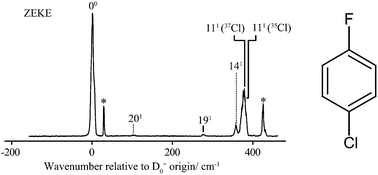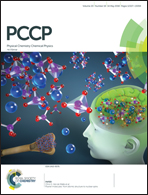Vibrations of the p-chlorofluorobenzene cation
Abstract
The vibrations of the ground state cation (![[X with combining tilde]](https://www.rsc.org/images/entities/char_0058_0303.gif) 2B1) of para-chlorofluorobenzene (pClFB) have been investigated using zero-electron-kinetic-energy (ZEKE) spectroscopy. ZEKE spectra were recorded using different vibrational levels of the S1 state as intermediate levels, for which assignments were put forward in an earlier paper [W. D. Tuttle, A. M. Gardner, and T. G. Wright, Chem. Phys. Lett., 2017, 684, 339]. These different intermediate levels dramatically modify the Franck–Condon factors for the ionization step. The adiabatic ionization energy (AIE) for pClFB was measured as 72 919 ± 5 cm−1, and analysis of the vibrational structure in the ZEKE spectra allowed further interrogation of the assignments of the REMPI spectrum. Assignment of the vibrational structure has been achieved by comparison with corresponding spectra of related molecules, via quantum chemical calculations, and via shifts in bands between the spectra of the 35Cl and 37Cl isotopologues. In this way it was possible to assign twenty out of the thirty vibrational modes of the ground state pClFB+ cation. Additionally, evidence for Fermi resonances between some vibrational levels was found in the S1 state, but no large-scale intramolecular vibrational redistribution (IVR) was seen in the spectra here. Finally, we discuss trends in AIE shifts for benzenes with one or two halogen atoms or methyl substituents.
2B1) of para-chlorofluorobenzene (pClFB) have been investigated using zero-electron-kinetic-energy (ZEKE) spectroscopy. ZEKE spectra were recorded using different vibrational levels of the S1 state as intermediate levels, for which assignments were put forward in an earlier paper [W. D. Tuttle, A. M. Gardner, and T. G. Wright, Chem. Phys. Lett., 2017, 684, 339]. These different intermediate levels dramatically modify the Franck–Condon factors for the ionization step. The adiabatic ionization energy (AIE) for pClFB was measured as 72 919 ± 5 cm−1, and analysis of the vibrational structure in the ZEKE spectra allowed further interrogation of the assignments of the REMPI spectrum. Assignment of the vibrational structure has been achieved by comparison with corresponding spectra of related molecules, via quantum chemical calculations, and via shifts in bands between the spectra of the 35Cl and 37Cl isotopologues. In this way it was possible to assign twenty out of the thirty vibrational modes of the ground state pClFB+ cation. Additionally, evidence for Fermi resonances between some vibrational levels was found in the S1 state, but no large-scale intramolecular vibrational redistribution (IVR) was seen in the spectra here. Finally, we discuss trends in AIE shifts for benzenes with one or two halogen atoms or methyl substituents.

- This article is part of the themed collection: 2018 PCCP HOT Articles


 Please wait while we load your content...
Please wait while we load your content...